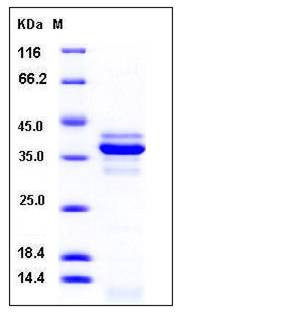Mouse Cathepsin L / CTSL Protein (His Tag)
1190035F06Rik,Ctsl1,fs,MEP,nkt
- 100ug (NPP3198) Please inquiry
| Catalog Number | P50015-M08H |
|---|---|
| Organism Species | Mouse |
| Host | Human Cells |
| Synonyms | 1190035F06Rik,Ctsl1,fs,MEP,nkt |
| Molecular Weight | The secreted recombinant mouse CTSL (pro form) consists of 328 amino acids and has a calculated molecular mass of 37.3 kDa. The recombinant protein migrates as several bands probably including the pro form, mature form, the pro peptide and the cleaved heavy chain in SDS-PAGE under reducing conditions. |
| predicted N | Thr 18 |
| SDS-PAGE |  |
| Purity | > 90 % as determined by SDS-PAGE |
| Protein Construction | A DNA sequence encoding the mouse CTSL (P06797) (Met 1-Asn 334) was expressed, with a C-terminal polyhistidine tag. |
| Bio-activity | |
| Research Area | Immunology |Innate Immunity |Lysosomal Enzymes |
| Formulation | Lyophilized from sterile 20mM Tris, 150mM NaCl, pH 7.5 1. Normally 5 % - 8 % trehalose and mannitol are added as protectants before lyophilization. Specific concentrations are included in the hardcopy of COA. |
| Background | Cathepsin L is a lysosomal cysteine protease that plays a major role in intracellular protein catabolism, and is potent in degrading collagen, laminin, elastin, as well as alpha-1 protease inhibitor and other structural proteins of basement membranes. It is secreted by liver flukes at all stages of their development in the mammalian host, are believed to play important roles in facilitating parasite migration (tissue degradation), feeding and immuno-evasion. Like many proteases, Cathepsin L is synthesized as an inactive preproenzyme, and cleavage of the 96-residue proregion is necessary to generate the fully active 221-residue mature enzyme. Studies have demonstrated that cleavage of the proregion occur autocatalytically under acidic conditions. The enzyme takes part in nutrient acquisition by catabolizing host proteins to absorbable peptides, facilitates the migration of the parasite through the host intestine and liver by cleaving interstitial matrix proteins such as fibronectin, laminin and native collagen and is implicated in the inactivation of host immune defenses by cleaving immunoglobulins. Recently, Cathepsin L has been shown to suppress Th1 immune response in infected laboratory animals making them susceptible to concurrent bacterial infections. Cathepsin L is synthesized in large amounts and secreted by many malignantly transformed cells, and induced by growth factors and tumor promoters. In addition to its role in protein degradation, evidence has accumulated for the participation of Cathepsin L in various physiological and pathological processes, such as tumor invasion and metastasis, bone resorption, spermatogenesis, and arthritis. Accordingly, Cathepsin L may prove useful as a diagnostic or prognostic marker of human tumor malignancy. |
| Reference |
